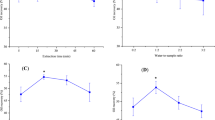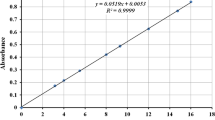Abstract
Fish oil is a rich source of polyunsaturated fatty acids, and its refinement has drawn attention for years. An appropriate adsorbent can effectively remove the pigment impurities in the fish oil. This study evaluated the impact of different absorbents on the reduction of oxidation products and color of anchovy oil during the decolorization under high vacuum. Using the single factor design, four process parameters including adsorbents type, adsorbent amount, temperature and time were tested to determine the optimum decolorization parameter. The results showed the optimum decolorization conditions were that the fish oil was treated with 8% activated alumina at 80 °C for 40 min. In the central group experiment, the addition amounts of mixed absorbents (activated earth and activated alumina), including the mass ratio of adsorbent in oil (5%–11%, w/w) and the mass ratio of activated earth in total absorbent (20%–80%, w/w) were optimized to remove the oxidation products. Under the optimum condition at 10.18% of adsorbent and 70% of activated earth, the total oxidation value (TOTOX value) showed the minimum with the 44.4% of removal rate. Eight metal elements were analyzed in decolorized oil using inductively coupled plasma mass spectrometry (ICP-MS). The removal rates of Zn and Pb were 94.12% and 55.35%, respectively. The decolorization process using mixed absorbents under appropriate condition can significantly reduce the oxidation products and pigments in fish oil, which will benefit the industrial production of fish oil.
Similar content being viewed by others
References
Asgari, S., Sahari, M. A., and Barzegar, M., 2017. Practical modeling and optimization of ultrasound-assisted bleaching of olive oil using hybrid artificial neural network-genetic algorithm technique. Computers and Electronics in Agriculture, 140: 422–432, https://doi.org/10.1016/j.compag.2017.06.025.
Chew, S., Tan, C., and Nyam, K., 2017. Application of response surface methodology for optimizing the deodorization parameters in chemical refining of kenaf seed oil. Separation and Purification Technology, 184: 144–151, https://doi.org/10.1016/j.seppur.2017.04.044.
Chutapa, S., Bhundit, I., and Chanin, T., 2013. Cytotoxicity of used frying oil recovered by different adsorbents. Kasetsart Journal — Natural Science, 47(6): 874–884.
Crexi, V. T., Souza-Soares, L. A., and Pinto, L. A. A., 2009. Crap (Cyprinus carpio) oils obtained by fishmeal and ensilage processes: Characteristics and lipid profiles. Food Science and Technology, 44(2): 1642–1648, https://doi.org/10.1111/j.1365-2621.2009.01982.x.
Daraei, P., Zereshki, S., and Shokri, A., 2019. Application of nontoxic green emulsion liquid membrane prepared by sunflower oil for water decolorization: Process optimization by response surface methodology. Journal of Industrial and Engineering Chemistry, 77: 215–222, https://doi.org/10.1016/j.jiec.2019.04.039.
Firestone, D., 1994. Official Methods and Recommended Practices of the American Oil Chemists’ Society. American Oil Chemists’ Society.
Frieler, L., Ho, T. M., Anthony, A., Hidefumi, Y., Yago, A. J. E., and Bhandari, B. R., 2019. Crystallisation properties of amorphous cyclodextrin powders and their complexation with fish oil. Food Scientists & Technologists, 56(3): 1519–1529, https://doi.org/10.1007/s13197-019-03643-7.
Gao, X., and Guo, Z., 2017. Biomimetic superhydrophobic surfaces with transition metals and their oxides: A review. Journal of Bionic Engineering, 14(3): 401–439, https://doi.org/10.1016/s1672-6529(16)60408-0.
García-Moreno, P. J., Guadix, A., Gómez-Robledo, L., Melgosa, M., and Guadix, E. M., 2013. Optimization of bleaching conditions for sardine oil. Journal of Food Engineering, 116(2): 606–612, https://doi.org/10.1016/j.jfoodeng.2012.12.040.
General Administration of Quality Supervision, Inspection and Quarantine of the People’s Republic of China, 2017. Maximum Levels of Contaminants in Foods. GB 2762-2017. Standards Press of China, Beijing (in Chinese).
Guner, M., Yilmaz, E., and Yuceer, Y., 2019. Off-odor removal from fish oil by adsorbent treatment with selected metal-organic frameworks. Flavour and Fragrance Journal, 34(3): 163–174, https://doi.org/10.1002/ffj.3489.
Hussin, F., Aroua, M. K., and Daud, W. M. A. W., 2011. Textural characteristics, surface chemistry and activation of bleaching earth: A review. Chemical Engineering Journal, 170(1): 90–106, https://doi.org/10.1016/j.cej.2011.03.065.
Icyer, N. C., and Durak, M. Z., 2018. Ultrasound-assisted bleaching of canola oil: Improve the bleaching process by central composite design. Food Science and Technology, 97(3): 640–647, https://doi.org/10.1016/j.lwt.2018.07.030.
Javed, M., and Usmani, N., 2017. An overview of the adverse effects of heavy metal contamination on fish health. Proceedings of the National Academy of Sciences, India Section B: Biological Sciences, 89(2): 389–403, https://doi.org/10.1007/s40011-017-0875-7.
Kowalski, R., Kowalska, G., Pankiewicz, U., Mazurek, A., Włodarczyk-Stasiak, M., Sujka, M., et al., 2019. The effect of an addition of marjoram oil on stabilization fatty acids profile of rapeseed oil. LWT-Food Science and Technology, 109: 225–232, https://doi.org/10.1016/j.lwt.2019.04.016.
Monte, M. L., Monte, M. L., Pohndorf, R. S., Crexi, V. T., and Pinto, L. A. A., 2015. Bleaching with blends of bleaching earth and activated carbon reduces color and oxidation products of carp oil. European Journal of Lipid Science and Technology, 117(6): 829–836, https://doi.org/10.1002/ejlt.201400223.
Osman, D. I., Attia, S. K., and Taman, A. R., 2018. Recycling of used engine oil by different solvent. Egyptian Journal of Petroleum, 27(2): 221–225, https://doi.org/10.1016/j.ejpe.2017.05.010.
Pitakpoolsil, W., and Hunsom, M., 2013. Adsorption of pollutants from biodiesel wastewater using chitosan flakes. Journal of the Taiwan Institute of Chemical Engineers, 44(6): 963–971, https://doi.org/10.1016/j.jtice.2013.02.009.
Plata, V., Rojas, Ó., and Gauthier-Maradei, P., 2020. Improvement of palm oil biodiesel filterability by treatment with reactivated spent bleaching earths. Fuel, 260: 116–125, https://doi.org/10.1016/j.fuel.2019.116198.
Sen, T. K., and Sarzali, M. V., 2008. Removal of cadmium metal ion (Cd2+) from its aqueous solution by aluminium oxide (Al2O3): A kinetic and equilibrium study. Chemical Engineering Journal, 142(3): 256–262, https://doi.org/10.1016/j.cej.2007.12.001.
Subramaniam, S., Witoon, P., Joan, M. K., Casey, C., and Lloyd, S., 2003. Oil production from catfish viscera. Journal of the American Oil Chemists’ Society, 80(4): 377–382, https://doi.org/10.1007/s11746-003-0707-z.
Suseno, S. H., Tajul, A. Y., Nadiah, W. A., and Noor, A. F., 2012. Improved of color properties on Sardinella lemuru oil during adsorbent refining using magnesol xl. International Food Research Journal, 19(4): 1383–1386.
Turan, S., Yalçuk, A., Şişlioğlu, K., and Ramadan, M. F., 2019. Purification of used sunflower frying oil with adsorbent mixtures using an active filtration method. Rivista Italiana Delle Sostanze Grasse, 96(3): 171–181.
Wang, W., Chen, H., and Wang, A., 2007. Adsorption characteristics of Cd(II) from aqueous solution onto activated palygorskite. Separation and Purification Technology, 55(2): 157–164, https://doi.org/10.1016/j.seppur.2006.11.015.
Wang, Z., Xu, J., Liu, Y., Li, Z., Xue, Y., Wang, Y., et al., 2019. Arsenic speciation of edible shrimp by high-performance liquid chromatography-inductively coupled plasmamass spectrometry (HPLC-ICP-MS): Method development and health assessment. Analytical Letters, 52(14): 2266–2282, https://doi.org/10.1080/00032719.2019.1608224.
Wen, Y. Q., Xue, C. H., Xu, L. L., Wang, X. H., Bi, S. J., Xue, Q. Q., et al., 2019. Application of plackett-burman design in screening of natural antioxidants suitable for anchovy oil. Antioxidants (Basel), 8 (12): https://doi.org/10.3390/antiox8120627.
Zakwan, J., E., and Lubis, Z., 2017. Production mono-diglyceride (MDG) from refined deodorized palm oil (RBDPO) by enzymatic process. International Food Research Journal, 24(1): 56–59.
Zhang, L. Y., Ding, L., Shi, H. H., Xu, J., Xue, C. H., Zhang, T. T., et al., 2019. Eicosapentaenoic acid in the form of phospholipids exerts superior anti-atherosclerosis effects to its triglyceride form in ApoE−/− mice. Food & Function, 10(7): 4177–4188, https://doi.org/10.1039/C9FO00868C.
Zhong, Y., Madhujith, T., Mahfouz, N., and Shahidi, F., 2007. Compositional characteristics of muscle and visceral oil from steelhead trout and their oxidative stability. Food Chemistry, 104(2): 602–608, https://doi.org/10.1016/j.foodchem.2006.12.036.
Acknowledgement
This work was supported financially by the Ocean University of China, under the Classification of Project Number of 2018YFC0311201.
Author information
Authors and Affiliations
Corresponding author
Rights and permissions
About this article
Cite this article
Wang, X., Wen, Y., Bi, S. et al. Bleaching with the Mixed Adsorbents of Activated Earth and Activated Alumina to Reduce Color and Oxidation Products of Anchovy Oil. J. Ocean Univ. China 20, 1167–1174 (2021). https://doi.org/10.1007/s11802-021-4732-1
Received:
Revised:
Accepted:
Published:
Issue Date:
DOI: https://doi.org/10.1007/s11802-021-4732-1




